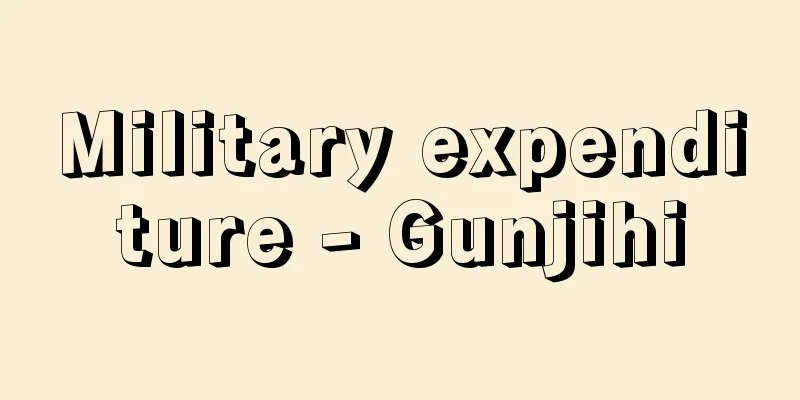Military expenditure - Gunjihi

|
National expenditures for military purposes are called defense expenditures in times of peace. Military expenditures are broadly divided into defense expenditures or military equipment expenditures in times of peace, war expenses, and postwar settlement expenses. [Tetsuya Hitosugi and Toru Haneda] Scope of military expenditureModern wars up until World War II were total wars fought by concentrating the full strength of a nation, so military expenditures were included in all sectors of national expenditures in peacetime to prepare for them. In other words, military expenditures in the narrow sense refer to the expenses of the Army, Navy, and Air Force, but often also include military pensions and military science and technology promotion expenses. In a broader sense, it also includes the payment of principal and interest on military bonds, subsidies to the military industry, construction expenses for railways, roads, ports, and airports with military purposes, overseas aid expenses, colonial management expenses, etc. In addition, conscription requires less financial expenditure than voluntary recruitment, but when considering the products that would have been obtained if the soldiers had been engaged in economic activities, the negative impact on the national economy can also be called "invisible military expenditures." [Tetsuya Hitosugi and Toru Haneda] The nature of military expenditureIn the total circulation process of the national economy, military expenditures are a typical example of unproductive consumption. In other words, they become effective demand as part of fiscal expenditures, but the goods and services produced through them are rarely reintroduced into the production process to increase productivity, except in cases where the development of military technology spreads to the civilian economy. If military expenditures increase, finite resources are consumed for military supplies, which reduces the allocation of resources to the civilian sector and reduces the circulation process of the national economy. The only thing that can be gained by spending military expenses is the maintenance and strengthening of national defense or defense capabilities, which is an intangible utility. When a nation-state was formed, the above utility was recognized as necessary to protect the country's unique territory and people, and maintaining military forces for national defense was considered an important task of the state. It is well known that Adam Smith, who considered government a "necessary evil," made national defense a national duty along with maintaining domestic security, public works for civil engineering and education, and diplomacy. However, in the so-called imperialist stage, military expenditures for market expansion, acquisition and maintenance of colonies, and military expenditures for maintaining a favorable balance of military power with other imperialist countries came to occupy a large proportion of the finances and national economy. This is the law of cost expansion that A.H.G. Wagner spoke of, and its ultimate end was the First and Second World Wars. [Tetsuya Hitosugi and Toru Haneda] Military spending until the end of the Cold WarThe following characteristics can be seen in the global trends in military spending from the end of World War II to the end of the Cold War at the Malta Conference in 1989. First, the idea of collective security was stronger than the defense consciousness of each country preserving its own territory and people. Good examples are the North Atlantic Treaty Organization (NATO) spanning North America and Europe, and the Warsaw Pact in the socialist world. Second, in the liberal world, what US President Eisenhower called a military-industrial complex was formed, and the weight of the military industry in the national economy, including arms exports, became so large that it became necessary to include the military industry in the management of the national economy and overseas military aid. Third, both conventional and strategic weapons became increasingly expensive in connection with the development of electronics. Fourth, the increase in military spending against this background put pressure on finances on both sides, greatly narrowing the room for choice between "butter or cannon." [Tetsuya Hitosugi and Toru Haneda] Military spending after the end of the Cold WarSince the end of the Cold War, the world has been moving toward disarmament and military spending reduction. According to the Military Balance (2000/2001) by the UK International Institute for Strategic Studies (IISS), world defense spending fell 35.5% from $1,253.5 billion in 1985 to $808.5 billion in 1999. World defense spending per capita also fell from $399 to $211, and regular military strength also fell from 27.95 million to 21.88 million. However, according to the Military Balance 2009, world defense spending in 2007 was $1,279.6 billion, almost the same as in 1985. One of the reasons for this is that emerging countries such as China and India are increasing their defense spending based on the financial resources they have gained from their economic development. Despite the increase in total expenditures, world defense expenditures per capita was $202 in 2007, slightly lower than in 1999, due to the increase in the world's total population. Furthermore, it is believed that the rising cost of weapons has increased the total amount of world defense expenditures, and the number of regular troops in 2007 was 20.49 million, a decrease from 1999. In any case, there is no doubt that these reductions in defense expenditures have been redirected to the civilian economy, generating energy and promoting world economic growth from the end of the 20th century to the beginning of the 21st century. Compared to the Cold War, the following characteristics can be noted in global military spending. First, there is a change in collective security. The Warsaw Pact was dissolved in 1991, while the North Atlantic Treaty Organization, while increasing its member states, is shifting its function from its own collective security to intervention and resolution of neighboring regional conflicts such as those in the former Yugoslavia. Second, in terms of military action, the United Nations has formed peacekeeping forces (PKFs) to deal with regional conflicts, and there have been an increasing number of cases in which multinational forces led by the United States have been formed to handle such conflicts. Third, although military spending has been reduced, the cost of weapons has not changed due to developments in electronics and military technology. [Tetsuya Hitosugi and Toru Haneda] Japan's military expenditureIn Japan before World War II, war expenses were paid for through the Special Account for Provisional Military Expenses, while military expenditures and postwar settlement expenses were paid for through the general account. The former was established during both the First Sino-Japanese War and the Russo-Japanese War, and its fiscal year was set to the end of the war. However, even after the war ended, provision for provision for military expenditures was often recorded as an item in the general account, and in the end provision for provision for military expenditures continued until the end of World War II. The sources of funding were government bonds, borrowings, and locally procured funds, and it can be said that Japan's wars were paid for through government bonds. Furthermore, military expenditures in the general account reached huge amounts even in peacetime, and were a constant strain on the already poor national finances. After the war, military expenditures were limited to postwar settlement expenses, but military expenditures gradually increased with the establishment of the National Police Reserve (later the Self-Defense Forces) in connection with the outbreak of the Korean War in 1950, four "Defense Programs" from 1958 to 1976, two five-year "Mid-Term Operational Estimates" from 1977, and five five-year "Mid-Term Defense Programs" from 1985. During this period, including the end of the Cold War in 1989, Japan's defense expenditures actually increased from $31.8 billion in 1985 to $41 billion in 2007. As a result, Japan ranked sixth in defense expenditures in 2007, behind the United States, the United Kingdom, France, China, and Germany. However, per capita expenditures in 2007 were $322, ranking 34th in the world. This suggests that Japan's military power was not necessarily incorporated into the Cold War structure of East-West conflict, and that its fiscal expenditures were not so large as to place pressure on other expenditures. It is also related to the fact that Japan has little historical experience of forming a national consensus on the defense of the nation, and that the country suddenly entered the era of collective security after World War II, and that national agreement on this has not necessarily been formed. [Tetsuya Hitosugi and Toru Haneda] "Showa Financial History 4: Extraordinary Military Expenses" edited by the Ministry of Finance Showa Financial History Editorial Office (1955, Toyo Keizai Shinposha)" ▽ "Defense Agency, Defense White Paper, various years' editions (Ministry of Finance Printing Bureau)" [References] | | | | |Source: Shogakukan Encyclopedia Nipponica About Encyclopedia Nipponica Information | Legend |
|
軍事上の目的のために支出される国家経費で、平時には国防費という。軍事費は、平時の国防費ないし軍備費、戦費、戦後処理費に大別される。 [一杉哲也・羽田 亨] 軍事費の範囲第二次世界大戦までの近代戦は一国の総力を結集して行われる総力戦であるから、それに備える平時の国家経費のあらゆる部門に軍事費が含まれることになる。すなわち、狭義の軍事費は陸海空三軍の経費を意味するが、軍人恩給や軍事科学技術振興費を含める場合も多い。さらに広義には、軍事公債の元利支払い、軍事産業への補助金、軍事目的をもつ鉄道・道路・港湾・空港の建設費、海外援助費、植民地経営費等々も包含される。また徴兵制は自由募兵制よりも財政上の経費は少なくてすむが、彼らが経済活動に従事していたならば得られたであろう生産物を考慮すると、その国民経済に与えるマイナスも「見えない軍事費」といえよう。 [一杉哲也・羽田 亨] 軍事費の性格国民経済の総循環過程において、軍事費は典型的な不生産的消費である。すなわちそれは、財政支出の一環として有効需要となるが、それによって生産された物資・サービスが生産過程に再投入されて生産力を伸長させることは、軍事技術の開発が民間経済に波及する場合などを除いては、あまりない。軍事費が増大すれば、有限な資源がそれだけ軍需品として消耗されるから、民生部門への資源配分が圧縮され、国民経済の循環過程が縮小するからである。 軍事費の支出によって得られるものは、唯一、無形の用益たる国防ないし防衛力の維持・強化である。国民国家が形成される時点においては、その国家固有の領土・国民を保全するために、前記の用益が必然と認められ、国防のため軍備を維持することは国家の重要な任務とされた。政府を「必要悪」としたアダム・スミスが、国内治安の維持、土木事業や教育のための公共事業、外交とともに、国防を国家の義務としたことはよく知られている。しかし、いわゆる帝国主義段階になると、市場拡大・植民地獲得および維持のための軍事支出、他の帝国主義諸国との軍事力バランスを優位に保つための軍事費が、財政上、国民経済上大きな比重を占めてくるようになる。A・H・G・ワーグナーのいう経費膨張の法則であり、その行き着く先が第一次、第二次の両大戦であった。 [一杉哲也・羽田 亨] 冷戦解消までの軍事費第二次世界大戦の終結から、1989年のマルタ会談による冷戦解消までの軍事費の世界的傾向には、次のような特徴がみられる。第一に、一国が自らの領土・国民を保全するという防衛意識よりも、集団安全保障の国防思想が強い。北米とヨーロッパにまたがる北大西洋条約機構(NATO(ナトー))、社会主義圏のワルシャワ条約機構が好例である。第二に、自由主義圏では、アメリカ大統領アイゼンハワーのいう産軍共同体が形成され、国民経済に占める軍事産業の比重が武器輸出を含めて巨大化したため、国民経済運営や海外軍事援助に軍事産業を包含して経営せざるをえなくなった。第三に、エレクトロニクスの発達と関連して通常兵器、戦略兵器ともますます高価になった。第四に、こうした背景に基づく軍事費の増大が両陣営を通じて財政を圧迫し、「バターか大砲か」の選択の余地がきわめて狭められていた。 [一杉哲也・羽田 亨] 冷戦解消後の軍事費冷戦解消後、世界はあげて軍縮・軍事費縮小に向かいつつある。イギリス国際戦略研究所(IISS)の『ミリタリー・バランス(2000/2001)』によると、世界の国防支出は、1985年の1兆2535億ドルから1999年の8085億ドルと35.5%減少した。また人口1人当りの世界の国防支出は、399ドルから211ドルへ減少、正規兵力も2795万人から2188万人へと減少している。しかしながら、『ミリタリー・バランス2009』によれば、2007年の世界の国防支出は1兆2796億ドルと1985年とほぼ同水準となっている。これは、中国やインドなど新興国とよばれる国々がその経済発展による資力をもとに国防支出を増大させていることが要因の一つとしてあげられる。人口1人当りの世界の国防支出は、総額の増加にもかかわらず、世界の総人口の増加により、2007年には202ドルと1999年と比べてわずかに減少している。さらに、兵器の高価化が世界の国防支出総額を増加させていると考えられ、2007年の正規兵力は2049万人で1999年と比べて減少している。いずれにしてもこれら国防支出の削減が民間経済へ振り向けられて活力を生み、20世紀末から21世紀初頭にかけての世界経済成長を促進していることは疑いない。 冷戦中と比較してみると、世界の軍事費には次のような特徴が指摘できよう。第一は、集団安全保障の変化である。ワルシャワ条約機構は1991年に解散し、一方、北大西洋条約機構は加盟国を増加させながら、それ自体の集団安全保障よりは旧ユーゴスラビアなど近隣の地域紛争への介入・処理へと機能を変えつつある。第二に、軍事行動としては、地域紛争に対して国連が平和維持軍(PKF)を編成し、またアメリカを中心に多国籍軍を編成して処理にあたる場合が増えた。第三に、縮小された軍事費とはいえ、エレクトロニクスと軍事技術の開発によって、兵器の高価化は変わっていない。 [一杉哲也・羽田 亨] 日本の軍事費第二次世界大戦前の日本では、戦費は臨時軍事費特別会計により、軍備費・戦後処理費は一般会計により処理されていた。前者は、日清(にっしん)戦争、日露戦争、両大戦時に設置され、戦争終結までを一会計年度としたが、戦争終結後もしばしば一般会計に臨時軍事費が費目として計上され、結局、第二次世界大戦終結まで臨時軍事費は続いていた。その財源としては、公債、借入金、現地調達資金があてられ、日本の戦争は公債でまかなわれたといえる。また一般会計上の軍備費も、平時においても巨額に達し、貧困な国家財政をつねに圧迫していた。 戦後、軍事費は戦後処理費だけとなったが、1950年(昭和25)の朝鮮戦争勃発(ぼっぱつ)に関連した警察予備隊(後の自衛隊)創設に始まり、1958年度から1976年度まで4次にわたる「防衛計画」、1977年度から2次にわたる各5年の「中期業務見積り」、1985年度以降、各5年の5次にわたる「中期防衛力整備計画」によって、軍事費はしだいに増大してきた。この間、1989年の冷戦解消を挟んで日本の国防支出額は、1985年の318億ドルから2007年(平成19)の410億ドルとむしろ増大している。その結果、国防支出額では2007年にはアメリカ、イギリス、フランス、中国、ドイツに次いで第6位となっている。ただし人口1人当りでは2007年は322ドルで、世界34位にとどまっている。これは日本の軍事力が、かならずしも東西対立の冷戦構造に組み込まれていなかったこと、財政支出面で他の支出を圧迫するほど規模が大きくなかったことを示唆している。また日本では、国民国家防衛という国民的コンセンサスが歴史上形成された経緯に乏しく、第二次世界大戦後いきなり集団安全保障の時代を迎えて、これに対する国民的合意がかならずしも形成されていないことも関連している。 [一杉哲也・羽田 亨] 『大蔵省昭和財政史編集室編『昭和財政史4 臨時軍事費』(1955・東洋経済新報社)』▽『防衛庁編『防衛白書』各年版(財務省印刷局)』 [参照項目] | | | | |出典 小学館 日本大百科全書(ニッポニカ)日本大百科全書(ニッポニカ)について 情報 | 凡例 |
Recommend
Alföld (English spelling) Alfold
… [Nature] Surrounded by the Carpathian Mountains...
Akikatsu Manabe
He was a senior councilor in the late Edo period ...
Adobe
Also known as sun-dried bricks, adobe is a type of...
Aspergillus disease (aspergillus blight)
A general term for diseases caused by the parasiti...
minuscule
…In the 3rd century, the Latin uncial and semi-un...
Flag
A pole or other stick with cloth or paper attache...
Wang Zhen (English spelling)
[Live] Guangxu 34 (1908).4. Hunan, Liuyang [Died] ...
Arima Naizen Sumiyoshi - Arima Naizen Sumiyoshi
…In 1724 (Kyoho 9), after the transfer of the lor...
Heat pump - Netsu pump
A machine that extracts heat from a low-temperatu...
Gapon Union - Gapon Union
…While studying at the seminary, he was influence...
Vellozia (English spelling)
A slightly woody perennial plant of the Velosiacea...
Armband - Udenuki
〘 noun 〙① A circular ornament worn on the upper ar...
tri-dhātu (English spelling)
…and the world with that structure. In Sanskrit, ...
gost' (English spelling) gost
…As mentioned at the beginning, the Latin word ho...
Tukulor
...He resisted the French army as a national hero...









